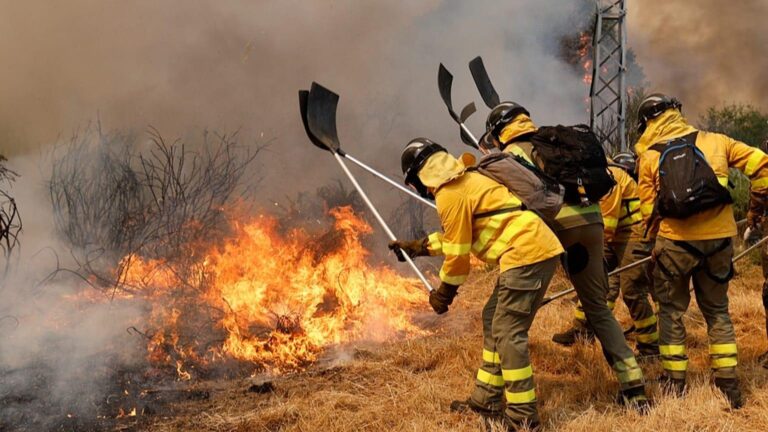After weeks of relentless blazes ravaging vast areas of Spain, recent reports indicate that the wildfires are beginning to stabilize. Cooler weather forecasts have bolstered hopes that the worst of the infernos may be behind the country. Firefighters, backed by improved conditions, continue their efforts to contain the damage as authorities remain vigilant against potential flare-ups. This development signals a critical turning point in Spain’s ongoing battle with one of the most severe wildfire seasons in recent memory.
Huge Wildfires Stabilising Across Spain Amid Coordinated Firefighting Efforts
Firefighting teams across Spain have reported a noticeable reduction in wildfire activity as a combination of coordinated ground operations and favorable weather conditions work in tandem to contain the blazes. Emergency services from several regions have mobilized over 5,000 personnel, including firefighters, volunteers, and military units, deploying advanced equipment and aerial support to tackle the ferocious flames engulfing vast forest areas. The collaboration between local authorities and national agencies has been critical in establishing firebreaks and protecting residential zones threatened by the encroaching fires.
Meteorologists forecast a period of cooler temperatures and increased humidity, which experts say will significantly aid suppression efforts and limit further spread. Key factors helping the containment include:
- Lower wind speeds reducing fire acceleration
- Nighttime moisture dampening dry vegetation
- Targeted aerial water drops in high-risk areas
| Region | Fire Status | Personnel Deployed |
|---|---|---|
| Andalusia | Stabilising | 1,800 |
| Catalonia | Controlled | 1,200 |
| Aragon | Contained | 900 |
| Castilla-La Mancha | Monitored | 600 |
Cooler Weather Brings Relief But Vigilance Remains Crucial for Fire Management
The recent drop in temperatures across the affected regions of Spain has offered a much-needed respite from the relentless heatwaves that fueled the devastating wildfires. Emergency teams have reported notable stabilization in several of the largescale blazes, attributing progress to the cooler forecast combined with sporadic rainfall. However, meteorologists caution that while these conditions ease the fire’s intensity, the underlying dryness of the terrain still poses a significant risk for flare-ups. Fire management authorities continue to monitor hotspots closely, emphasizing the importance of sustained vigilance during this transitional weather period.
Authorities have reinforced strategic efforts by deploying additional resources to vulnerable zones, ensuring rapid response capability should fires reignite. Key strategies currently in place include:
- Increased aerial surveillance to detect emerging threats quickly
- Community alerts advising heightened awareness and fire prevention measures
- Expanded fire breaks and controlled burns to reduce available fuel
| Region | Fire Status | Current Risk Level |
|---|---|---|
| Aragon | Contained | Moderate |
| Valencia | Stabilising | Moderate |
| Castilla-La Mancha | Under Control | Low |
Authorities Urge Continued Caution and Preparedness as Recovery Operations Begin
Local and national authorities have emphasized the importance of remaining vigilant as recovery efforts commence following the stabilization of the massive wildfires engulfing parts of Spain. Despite promising weather forecasts indicating a drop in temperatures and increased humidity, officials warn that conditions remain volatile, especially in areas with difficult terrain and residual hot spots. Emergency teams continue to conduct aerial surveillance and ground patrols to prevent flare-ups, while communities in the most affected zones are urged to maintain clear evacuation routes and heed official guidance.
Recommended precautions include:
- Keeping firefighting equipment accessible
- Monitoring local news for updates
- Reporting any signs of smoke or fire immediately
- Following temporary road closures and restrictions
- Remaining prepared for sudden weather changes
| Recovery Phase | Key Action | Responsible Entity |
|---|---|---|
| Containment | Patrol hot spots and reinforce firebreaks | Forest Service & Firefighters |
| Evacuation Support | Assist displaced families and provide shelter | Local Civil Protection |
| Damage Assessment | Evaluate ecological and infrastructural impact | Environmental Agencies |
| Community Aid | Distribute aid and psychological support | NGOs & Government Authorities |
Insights and Conclusions
As wildfire activity in Spain begins to stabilize amidst cooler temperatures, officials remain cautiously optimistic that the worst may be behind them. While vigilance continues, the improved conditions offer a much-needed reprieve for affected communities and emergency responders. Ongoing monitoring and support will be essential to ensure the fires remain contained as the region recovers from one of its most severe fire seasons in recent years.




